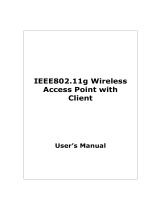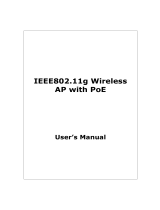
Table of Contents
1 INTRODUCTION................................................................................................................................5
1.1 FEATURES & BENEFITS .................................................................................................................6
1.2 PACKAGE CONTENTS ....................................................................................................................7
1.3 BRIDGE/AP DESCRIPTION .............................................................................................................7
1.4 ETHERNET CABLE WATER PROOF KIT INSTALL GUIDE...................................................................8
1.5 MOUNTING INSTALL GUIDE ..........................................................................................................9
1.6 SYSTEM REQUIREMENTS.............................................................................................................11
1.7 APPLICATIONS.............................................................................................................................11
1.8 NETWORK CONFIGURATION........................................................................................................11
a) Ad-hoc Mode (Bridge) ......................................................................................................................... 12
b) Infrastructure Mode (AP Client)........................................................................................................... 12
2 UNDERSTANDING THE HARDWARE.........................................................................................13
2.1 HARDWARE INSTALLATION.........................................................................................................13
2.2 IP ADDRESS CONFIGURATION.....................................................................................................13
3 CLIENT BRIDGE MODE – WEB CONFIGURATION................................................................15
3.1 LOGGING IN ................................................................................................................................15
3.2 SYSTEM.......................................................................................................................................17
3.2.1 ADMINISTRATOR SETTINGS.........................................................................................................17
3.2.1.1 SAVE CONFIGURATION TO A FILE...........................................................................................19
3.2.1.2 RESTORE THE CONFIGURATION FROM A FILE .........................................................................19
3.2.1.3 SWITCH DEVICE TO AP MODE................................................................................................19
3.2.2 FIRMWARE UPGRADE..................................................................................................................20
3.2.3 SYSTEM REBOOT AND RESTORE SETTINGS TO DEFAULT.............................................................22
3.2.3.1 SYSTEM REBOOT....................................................................................................................22
3.2.3.2 RESTORE SETTINGS TO DEFAULT ...........................................................................................23
3.2.4 SYSTEM TIME CONFIGURATION ..................................................................................................23
3.3 WIRELESS....................................................................................................................................25
3.3.1 SSID CONFIGURATION................................................................................................................25
3.3.1.1 802.11A INFRASTRUCTURE / AD-HOC MODE..........................................................................26
3.3.2 802.11B INFRASTRUCTURE / AD-HOC MODE...............................................................................27
3.3.3 WIRELESS 802.11G CONFIGURATION ..........................................................................................28
3.3.4 WIRELESS SECURITY...................................................................................................................29
3.3.4.1.1 WEP (WIRED EQUIVALENT PRIVACY) ...................................................................................29
3.3.4.1.2 WPA/WPA2 – PERSONAL (WI-FI PROTECTED ACCESS)........................................................30
3.3.5 ADVANCED WIRELESS SETTINGS ................................................................................................31
3.3.6 SNMP.........................................................................................................................................32
3.4 LAN SETTINGS (STATIC / DHCP)...............................................................................................33
3.5 LOGS...........................................................................................................................................34
3.6 STATISTICS..................................................................................................................................36
4 ACCESS POINT MODE – WEB CONFIGURATION..................................................................37
4.1 LOGGING IN ................................................................................................................................37
4.2 SYSTEM.......................................................................................................................................38
4.2.1 ADMINISTRATOR SETTINGS.........................................................................................................38
4.2.1.1 SAVE CONFIGURATION TO A FILE...........................................................................................38
4.2.1.2 RESTORE THE CONFIGURATION FROM A FILE .........................................................................39
4.2.1.3 SWITCH DEVICE TO BRIDGE MODE ........................................................................................39
4.2.2 FIRMWARE UPGRADE..................................................................................................................40
4.2.3 SYSTEM REBOOT AND RESTORE SETTINGS TO DEFAULT.............................................................41
4.2.3.1 SYSTEM REBOOT....................................................................................................................42
4.2.3.2 RESTORE SETTINGS TO DEFAULT ...........................................................................................42
4.2.4 SYSTEM TIME CONFIGURATION ..................................................................................................43





















